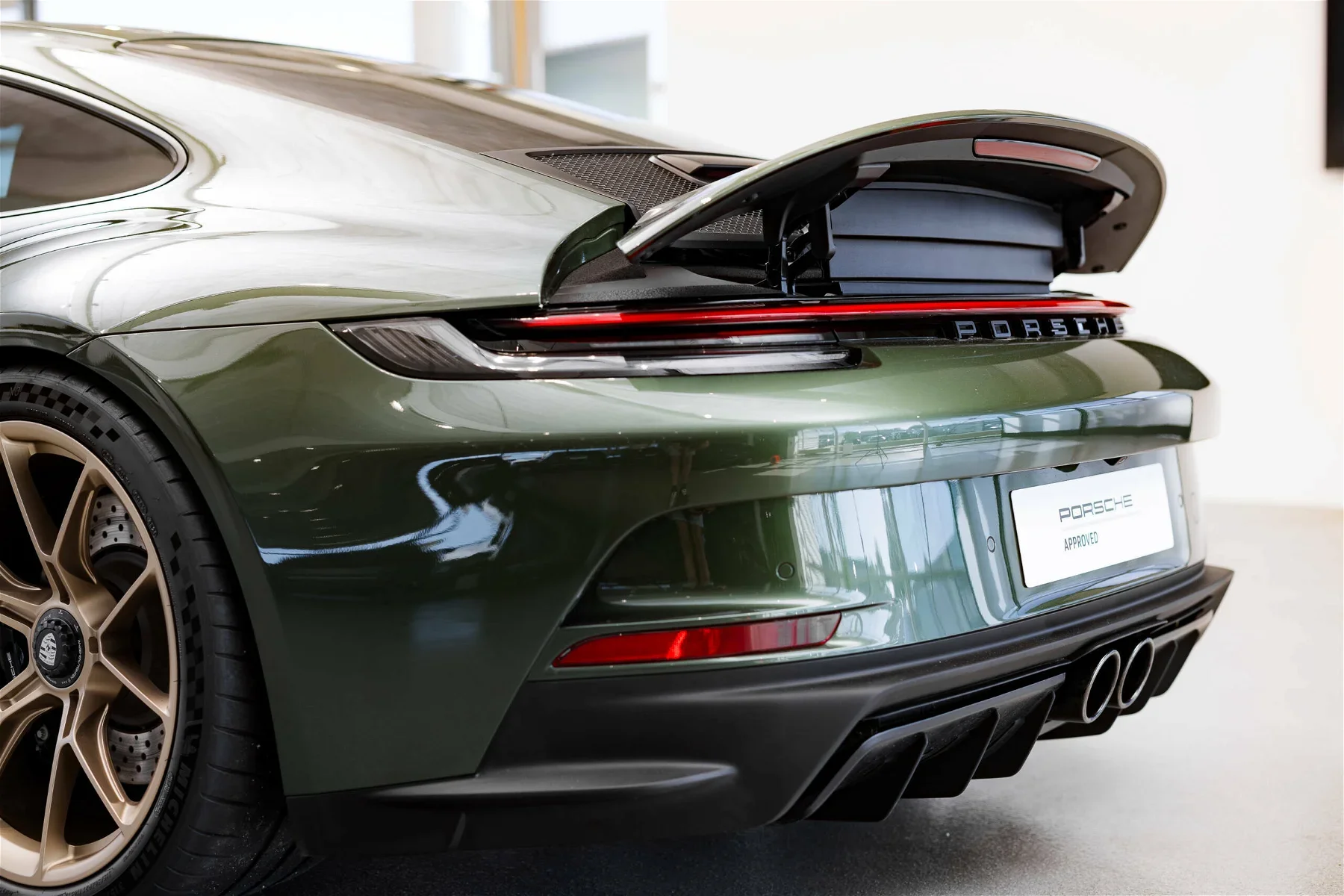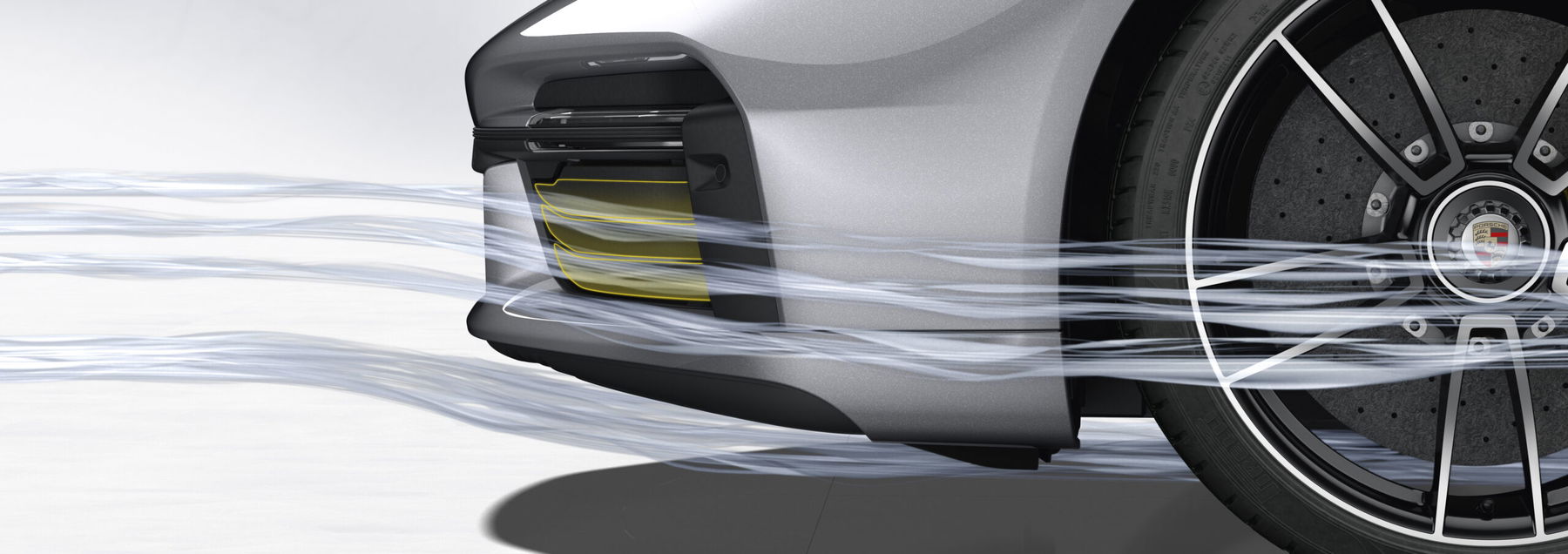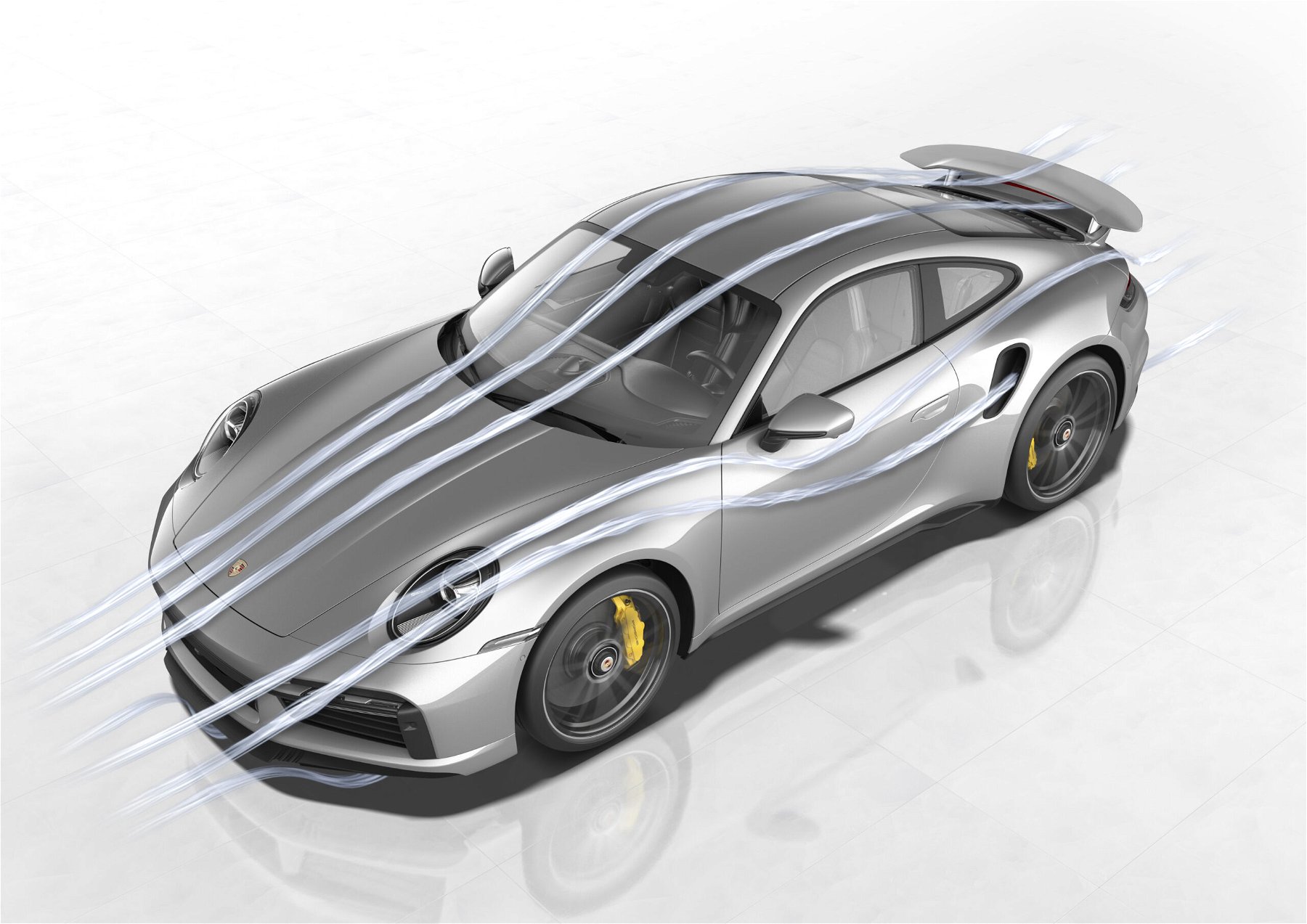Porsche has always been an industry leader in both technological development, as well as end-product execution. Approximately 6,700 employees at the Development Centre in Weissach are dedicated to advancing Porsche technology and pushing the limits of automotive engineering. The Development Centre, just 25 kilometers from Porsche’s headquarters in Stuttgart is where Porsche Active Aerodynamics (PAA) was born. As with many Porsche innovations, PAA was developed in the design studio, tested in the wind tunnel and honed at the racetrack. For those who might not be familiar with the terminology: Active aerodynamics refers to devices that can actively manipulate the air flow behaviour around the car – for example through extendable spoilers or adjustable air intakes – in different directions such as less drag or more downforce.
The dilemma of aerodynamic engineers – balancing drag and downforce
“We aerodynamic engineers are normally faced with a dilemma: a low drag coefficient is desirable to achieve a higher top speed and lower fuel consumption, while a high amount of downforce is advantageous for driving dynamics. However, the two characteristics contradict each other,” stated Dr Thomas Wiegand, Head of Aerodynamics Development at Porsche. He further explained that “Porsche Active Aerodynamics resolves the conflicts between these different aerodynamic goals”.
We aerodynamic engineers are normally faced with a dilemma: a low drag coefficient is desirable to achieve a higher top speed and lower fuel consumption, while a high amount of downforce is advantageous for driving dynamics. However, the two characteristics contradict each other
Dr Thomas Wiegand, Porsche Head of Aerodynamics Development
In this article, we will explore the beginning of Active Aerodynamics and how it has evolved to Weissach’s amazing present day offerings. Many of the Porsche Active Aerodynamics’ elements have been carried over from one model range to another. As such, only the more notable technological advancements will be highlighted.
Porsche Active Aerodynamics – Early developments with the Porsche 964
As a young teenager I remember seeing a Porsche 964 Carrera (1989-1994) merging onto a major roadway near my home town. As it accelerated, a motorized spoiler popped up from the rear deck-lid. To a young sports car fan, that was the coolest thing I had ever seen in my life. I was so intrigued that the next day, I rode my bike to the local bookstore. As this was way back in the pre-internet-days, I had to buy a magazine to learn more about these inspiring cars.




The “retractable rear spoiler” as Porsche calls it, was standard in the Carrera 2 and Carrera 4 models. The spoiler was designed to extend around 80 kph and then retract around 10 kph. That way Porsche wanted to maintain “the purity of the classic 911 body design” as stated in promotional materials. When extended, the spoiler increased rear downforce and therefore improved high-speed stability. But the first Porsche Active Aerodynamic device had another trick up its sleeve as it also doubled the volume of air flow into the engine bay. That created more efficient cooling.
From 1990, the retractable rear spoiler could also be operated manually
For the 1990 models, Porsche also added a switch on the center console that allowed the driver to manually operate the spoiler. This configuration has been the single Porsche Active Aerodynamics device for multiple decades. Because the retractable rear spoiler has remained as a fundamental design on all Porsche Carreras even up until this day. The exceptions were cars with special packages like the factory aero kit, sports design, etc. Even the newest Porsche 992 GT3 Touring has the understated retractable rear spoiler. Although it works at a bigger angle than the Carrera’s.

Several non-911 models have also featured some variation of the retractable rear spoiler. Cayman, Boxster, Panamara, Taycan and even the Cayenne share this technology. As cars have become faster since the introduction of the 964, the speeds at which the spoilers extend and retract have also changed. On new models we’re talking about 121 kph for extending and retracting at 60 kph.
Porsche Active Aerodynamics – Race Tracks to City Streets – 991 Turbo (2014-2019)
Porsche Active Aerodynamics as a proper name debuted over ten years ago. They really pushed the boundaries with the 2014 Porsche 991 Turbo and Turbo S. The goals of PAA as mentioned above by Dr. Wiegand, were to reduce drag but at the same time create more downforce. Not an easy task for Porsche engineers. PAA has three stages of operation where the front and rear spoilers work in harmony to get the best out of the car.
The Porsche 991 Turbo’s front spoiler is made from a flexible pneumatic elastomer. It is a rubbery material that is capable of recovering its original shape after being stretched. The outer portions of the front spoiler will extend slightly downward when the speed of 121 kph is reached. The front and rear spoiler can extend or retract as required and work in harmony with each other. Spoilers extend even further when performance driving is required. It was the first time this technology was used on a road car having first been derived from similar systems found on Porsche race cars. There are 3 stages of operation for this system:






Supercar Aero – 918 Spyder (2013-2015)
The Porsche 918 Spyder has similar active aero settings as the 991 Turbo. They are called Start, Speed and Performance. But, again for the first time on a road car, Porsche implemented adjustable air flaps at the front underbody of the Spyder. These flaps opened when “Performance” mode was selected. The intakes direct air through under-body diffuser channels, creating a section ow lower air pressure below the car. That essentially is the opposite effect of a plane’s wing, therefore creating downforce instead of lift. In Performance mode, the rear wing is set to a more aggressive angle and the small spoiler on the wing’s trailing edge extends. That both increases downforce at the rear.

In the “Speed” setting, rear wing angle changes slightly to keep some downforce but lessen drag at higher speeds. The spoiler remains deployed but the underbody flaps close for higher speed stability. For the “Start” mode, the rear wing and spoiler are retracted and the underbody flaps are closed. That provides the least amount of drag of all the settings.
The Porsche Active Aerodynamics System on the 918 Spyder worked in conjunction with the hybrid drive modes. There is a second set of adjustable air intakes located under the headlights. These are intended for cooling and always open in “Race Hybrid” or “Sport Hybrid” mode. However, these intakes then close under “E-Power” and “Hybrid” mode to reduce overall drag. They do not reopen until the 918 reaches 130 kph or the need for additional cooling is detected.




Porsche Active Aerodynamics set new benchmark – 992 Turbo (2020 – Present)
For the 2020 model year, Porsche’s 992 Turbo and Turbo S were released with shock and awe to motoring journalists and the masses alike. “No other sports car reacts to different situations with such aerodynamic flexibility as the new 911 Turbo S”, stated Dr. Wiegand upon its launch. It makes sense that a car with 641 hp (Turbo S) offers that kind of flexibility to help keep itself out of trouble and at the same time, reach Porsche’s lofty performance goals.



The wizards at the Porsche Development Centre improved the drivability of the 992 Turbo in all situations by further developing Porsche Active Aero. For Porsche’s flagship 911, PAA now has eight different configurations. One notable addition is that of an “airbrake”. When hard braking occurs, the front spoiler will lower and the rear wing extends to its most aggressive setting. This way it adds as much resistance as possible to help slow the car down.
“Performance 2” and “Wet” were also added to the PAA repertoire. “Performance 2” snuggles itself between “Performance 1” and “Speed” becoming a hybrid of both functions. It assists with stability at speeds once 257 kph is reached. In “Performance 2”, drag is slightly reduced and less downforce is present at the rear. When wet conditions are detected (in any mode), the rear spoiler raises (but does not tilt) to ensure as much downforce/grip as possible can be provided at the rear end.



Formula One Inspired Aero for peak on-track performance – Porsche 992 GT3 RS
Without a doubt, Porsche’s latest track focused weapon has the most advanced aero kit ever released from the manufacturer. Surprisingly, this is the first time PAA has been used on a GT3 RS. But what is not surprising is that Porsche wanted to get the aero exactly right, dedicating over 250 hours of development to it in the wind tunnel. This 992 GT3 RS, puts down an incredible 860 kg of downforce into the tarmac at 285 kph. The 992 GT3 RS produces twice the downforce of the 991.2 GT3 RS and three times as much as its tamer brother, the 992 GT3.
The 992 GT3 RS produces twice the downforce of the 991.2 GT3 RS and three times as much as its tamer brother, the 992 GT3.
Active aero on the 992 GT3 RS considers speed, lateral acceleration, steering angle and the selected driving mode to determine which one of the multitude of responses it will provide. One big (literally) part of the GT3 RS aero package is the enormous two-piece rear wing. It is taller than the roofline of the car and screams “function over form”. It automatically adjusts in a number of ways/degrees to prepare the driver and car for every possible situation.
Porsche opted for a single center cooler to optimize airflow
Porsche did away with its usual, dual-front corner radiators for the 992 GT3 RS. Instead, moving to a single radiator solution. The new vacant real estate that followed allowed Porsche the opportunity to use adjustable air intakes. They channel air through the front fender louvers and openings in front of the doors. This quick escape of air creates low pressure at the front of the car which increases downforce and helps keep the GT3 RS balanced. Porsche also included an airbrake feature similar to the aforementioned 992 Turbo to help with deceleration.
Porsche’s engineers spent more than 250 hours in the wind tunnel tuning the active aerodynamics of the 992 GT3 RS.
Another first for Porsche is its use of a drag reduction system (DRS) in a production car. Yes, DRS like in F1 cars. When DRS is enabled, the 992 GT3 RS wing flattens out and the front diffusers automatically open to maintain stability and achieve the most stable high speed setting. It will activate automatically when certain driver inputs/conditions are met. The speed must be over 100 kph, engine RPM above 5,500, less than 0.9G of lateral acceleration and at least 95 percent throttle input. DRS can also be manually initiated in certain conditions (minimal lateral acceleration and steering angle) from a button on the steering wheel.
DRS is typically used down long straights where cornering is not required but passing your buddy on a track day is. Interestingly though, the 992 GT3 RS top speed is lower (296 kph) than that of the 992 GT3 (318 kph) due to greater aerodynamic drag and a shorter final drive.


The Future of Porsche Active Aerodynamics
Porsche moved the active aero dial significantly with the introduction of the 992 Turbo and GT3 RS. It will be interesting to see, where they’ll find areas to improve any ruther. But as history has shown, the engineers at Porsche will continue to push to new limits and set a new bar for all others to aspire in achieving. We can’t wait to see what comes next and will be watching the various Porsche factory racing cars and Formula One for some potential hints.
© images: Porsche AG if not marked otherwise
Elferspot magazine
You have reached your article limit for this month.
Become an Elferspot Member now and get unlimited access to our Elferspot Magazine and other features!
- No obligations or charges.
- We help you find your dream car: get newly added cars straight into your mailbox.
- Your own watch list for your favorite cars.
- Unlimited access to Elferspot Magazin.
- -10% welcome discount for Elferspot textile products
- Successfully sell your Porsche via Elferspot.










